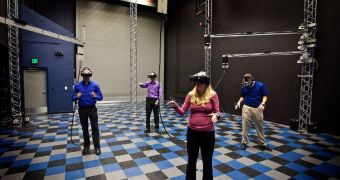A new satellite processing facility, recently opened in Littleton, Colorado, will use special 3D glasses and virtual reality technology to develop the next generation of American Global Positioning Satellites (GPS). The factory was built by Lockheed Martin, one of the primary contractors for the project.
The 50,000-square-foot (4,645-square-meter) facility was opened in February, and includes a massive test area, as well as a spacecraft assembly room, high-bay clean rooms and a number of test chambers.
This investment may seem excessive for building just one satellite, but Lockheed is under contract with the United States Air Force for as many as 32 GPS 3 series satellites. The USAF 2nd Space Operations Squadron is in charge of operating the expanding constellation.
The organization is responsible for distributing positioning and navigation data to both military and civilian customers, as well as international partners. The Squadron is based at the Schriever Air Force Base, in Colorado Springs.
Under its new federal contract, Lockheed needs to construct as many as four GPS 3 satellite annually. However, the company opted to develop a production facility where it can build up to 7 spacecraft in identical conditions, Space reports.
The announcement was made by Mark Valerio, who is the vice president and general manager for surveillance and navigation systems at Lockheed. He also explained that each satellite would need to remain airborne for at least 15 years.
Current-generation spacecraft can endure in space for periods of time ranging from 5 to 8 years. This means that new satellites have to be launched constantly to replenish the diminishing constellation, which in turn translates into very high costs for the USAF.
The worst part is that more than half of the existing GPS fleet is made up of satellites that have long since exceeded their mission design lifetimes. This means that they are operating as temporary replacement for what should be new satellites
“Like in aircraft and automobile production, each GPS 3 satellite will move through sequential workstations for various assembly and integration operations, culminating with environmental test procedures,” Valerio said during the opening ceremony.
The first GPS 3 is scheduled to launch as early as 2014. A testbed for the technology has already been produced by Lockheed; a full-size prototype that will not fly to space. This vehicle is used to troubleshoot any of the problems that may occur during construction, assembly and testing.

 14 DAY TRIAL //
14 DAY TRIAL //